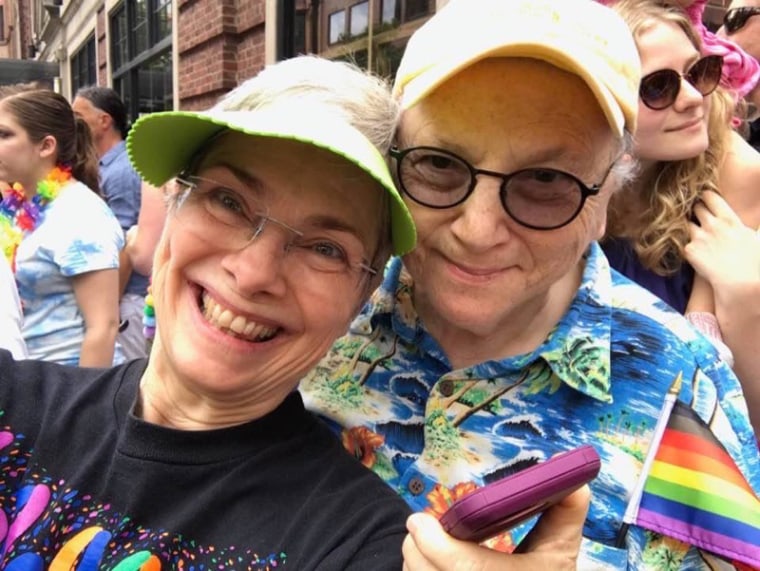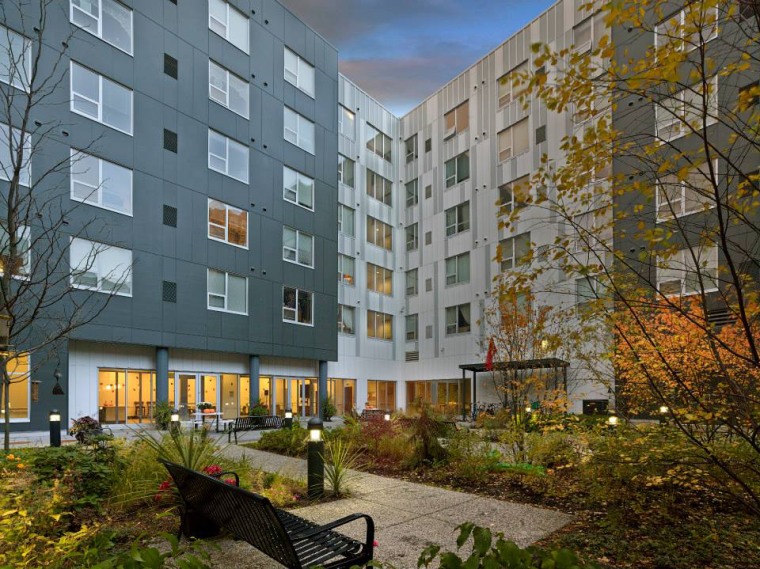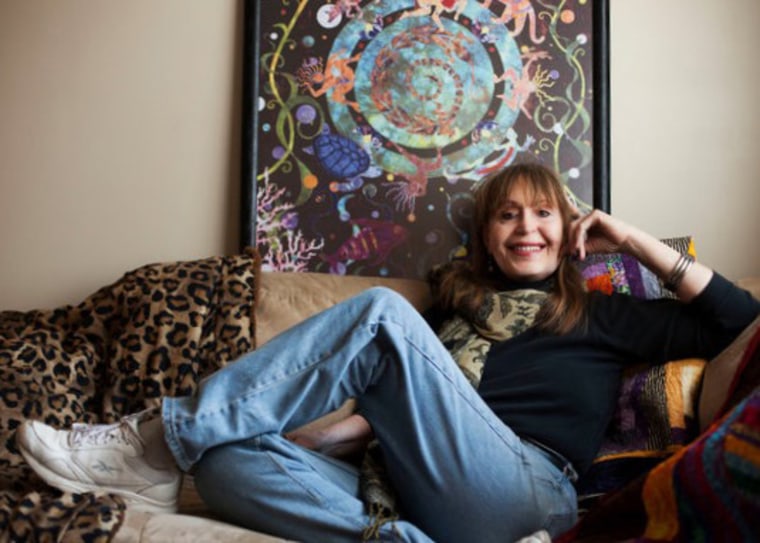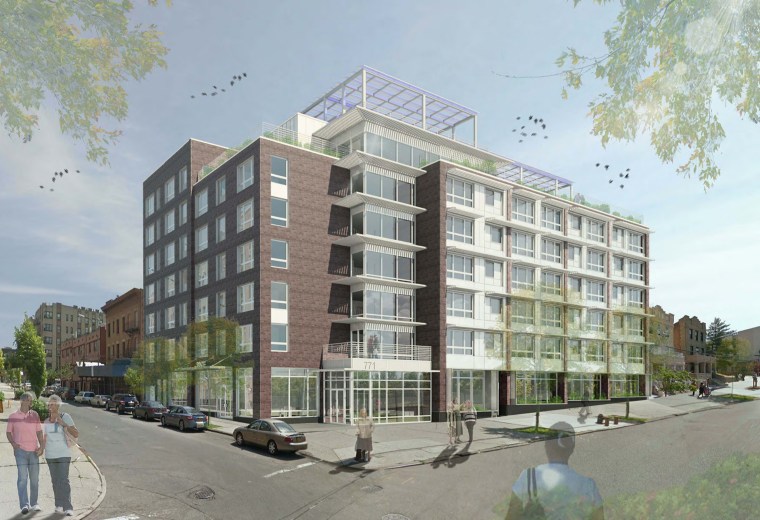Suz Atlas stepped out of the closet in 1994 following her marriage to a man, and she made a vow to never look back. But in 2017, she found herself at a crossroads.
Following several battles with cancer, Atlas and her partner, Mary Groce, were deep in debt and no longer able to afford their New Jersey apartment. They thought there may only be one way out: moving to a nursing home or an assisted living facility.
“My partner did work in a nursing home; we were aware there were no out people,” Atlas, now 76, told NBC News. “We thought to get into a decent facility, we may have to go back in the closet.”

There are an estimated 51 million people age 65 and older in the United States, according to the latest Census data, and at least 1.1 million of them are thought to identify as lesbian, gay, bisexual or transgender. Among the aging LGBTQ population, Atlas’ story is not uncommon: Almost half of older same-sex couples have reported experiencing housing discrimination, according to a 2014 survey by the Equal Rights Center.
Atlas and her partner, however, said they were “saved” when an apartment opened up in an LGBTQ-friendly affordable housing complex in nearby Philadelphia. Today, they pay rent adjusted to their income and will be able to live out their golden years in a community where they feel accepted.
“This place affords me the chance to be human. I don’t have to hide. I can be myself: a badass butch,” Atlas said with a chuckle.

Philadelphia’s John C. Anderson Apartments, which opened in 2014 and boasts 62 units, is just one of nine government-funded and explicitly “LGBTQ-friendly” affordable housing communities to spring up across the U.S. over the past decade. It follows in the footsteps of similar communities in Minneapolis, Cleveland, Los Angeles, Chicago, San Francisco and San Diego.
The mission of these communities is to create an inclusive and welcoming environment for an aging population that faces a unique set of challenges. These senior housing facilities foster an accepting environment by, for example, explicitly letting prospective residents know the building or complex is “LGBTQ-friendly,” hosting events onsite to benefit local LGBTQ nonprofits and facilitating meetings or support groups for various LGBTQ organizations.
When it comes to LGBTQ acceptance, age isn’t just a number. According to a survey released earlier this year by Pew Research Center, those born between 1928 and 1945 — the age range of many in nursing homes and assisted living facilities — are significantly less accepting than those from younger generations. While 45 percent of those ages 74 to 91 support same-sex marriage, 74 percent of those between 23 and 38 do.
And when compared to their non-LGBTQ counterparts, LGBTQ adults ages 80 and older also have higher disability rates, an increased likelihood of developing chronic diseases and are more prone to psychological and mental health disparities, according to a federally funded study published earlier this year.
“I’ve heard from many people that they feel unsafe as they age in public services,” Karen Fredriksen Goldsen, the study’s lead author, told NBC News. “That’s why it’s critical to develop LGBT-friendly housing, competent providers and LGBT housing environments that are supportive.”
LGBTQ elders are also less likely to have a partner or a child as a caregiver, according to a 2015 study by the National Alliance for Caregiving and the AARP. The report found LGBTQ older adults are “twice as likely to age as a single person, twice as likely to reside alone, and three to four times less likely to have children.”
“As their support system gets smaller, it leaves them at risk, because they have no safety net,” Fredriksen Goldsen said.
Mark Segal, a veteran of the historic 1969 Stonewall uprising and a leading advocate for LGBTQ affordable housing, noted that the lesbian, gay, bisexual, transgender and queer people now entering their golden years are “the first out generation.”
“If you were open about your sexuality in the 1950s and 1960s, you lost touch with relatives, you could not get a job with a 401(k) or pension program,” he explained. “It’s up to us to create a support group for our LGBT seniors.”
“We’re discovering the kind of abuse that takes place in other homes,” Segal said of housing facilities that are not LGBTQ-affirming. “We found people who were literally circled by neighbors attempting to ‘pray the gay’ out of them. Others who were denied visits with long-term partners. That’s why there’s a need for this.”

Elizabeth Coffey-Williams, 71, a transgender woman who is a resident of the John C. Anderson Apartments, said living in an “affirming space” helps her focus on her advocacy work. She also noted, however, that in addition to some of the unique challenges LGBTQ elders face, they also experience many of the same struggles as the broader senior community.
“Ageism is rampant, and when people reach a certain age, they are viewed as being disposable,” she said. “Well you know what, we’re not disposable.”
The movement for LGBTQ affordable housing communities is expected to heat up nationwide with about a dozen new affordable communities in the planning stages, according to Segal. He said an LGBTQ-inclusive affordable housing community generally takes about three to five years to build and costs around $20 million depending on the location and the size of the project.
Two LGBTQ-friendly affordable housing communities are set to open in New York City within the next year. The buildings, one in Brooklyn and one in the Bronx, will have 228 units combined and are expected to house between 300 and 400 residents. The projects are funded by the city and state are being led by SAGE, a nonprofit that specializes in creating housing and community support for LGBTQ elders.

Guy Aiossa, 67, is a retired hair and makeup artist who lives in Brooklyn. He’s also one of more than 2,000 LGBTQ seniors who applied for housing in the forthcoming New York City buildings within the first 10 minutes of the applications going online. Aiossa doesn’t know if he’ll be selected to get an apartment, but he’s hopeful.
“I want to move in there, because the neighborhood I live in now is not safe at all,” he said. “There are gangs and drugs and prostitution, and they’re extremely homophobic, and I really have no friends in the area with my interests.”
“There is no one gay or in my age group,” Aiossa added. “I like the idea of being with my people. This would be an ideal place for me if it works out.”
Michael Adams, CEO of SAGE, noted 2019 is the 50th anniversary of the Stonewall uprising, an event many credit with sparking the modern-day gay rights movement.
“That’s where this generation began its work,” he said. “Now it’s breaking new ground.These kinds of housing developments are beacons of light for LGBT elders.”
Senior housing facilities that are explicitly affirming, Adams added, are just the beginning.
“We have to do work to make sure that the broader senior housing sector is welcoming to LGBT adults,” he said. “At the end of the day, that's where the majority are going to live.”



